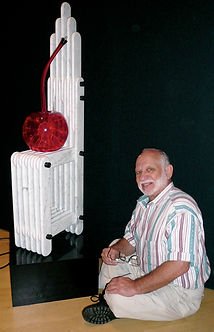Artist Statement

I have always been intrigued by the interplay of form, light and motion in space. Starting in the late 1950’s, I studied and then practiced architecture and urban design while keeping an interest in sculpture and graphics. However, with the political upheavals of the 1960’s, I felt compelled to shift my focus to city planning, community-based economic development and affordable housing finance. At the time, these seemed much more socially relevant.
After some thirty years, my long suppressed interest in sculpture and
graphics began to reemerge and fuse with my continuing interest in physics and geometry. Concurrently, I was strongly drawn to the new theories of self-organizing chaos as well as the related concept of emergence. Simply put, the term "self-organizing chaos" refers to the ability of certain seemingly random systems to self-organize, as well as self-replicate and behave according to rules that are not readily apparent outside of the system with often unpredictable results. “Emergence” refers to the appearance of a new phenomenon that has a nature beyond its component parts and is generally not predictable from an analysis of those parts.
At first I toyed with the expression of these new ideas through the kinetic graphics of video feedback. But as my sculptural predilections took hold, I decided to find ways to create self-organizing chaos in space and time. A gas plasma manifestation analogous to the Aurora Borealis or Northern Lights seemed to be the right approach. However, since I was not yet able to work on such a grand scale, I found the closest applicable technologies to be that of neon and the Tesla-derived plasma globes appearing in specialty shops.
What these more earthly items had most in common was the need to use glass to enclose a gas. Because there were no local classes available to me that taught neon and plasma techniques, I returned to school at the age of 55 to study glass, the material required to contain and maintain observable gas plasma on our terrestrial level. Thus for several years, I took about all of the studio classes offered in the Glass Sculpture Department at the California College of the Arts in Oakland, California, which is located down the block from my home. Also, being nostalgic for summer camp, I spent several summers at the Pilchuck and Corning glass schools, which included work with neon and plasma.
Nevertheless, I developed most of the gas plasma and requisite electronic techniques for my work on my own through extensive experimentation and trial-and-error, an alchemist’s approach, but with special thanks to the writings and patents of Nikola Tesla which I had devoured. Not being a master glass blower, I also developed a simple and inexpensive glass solder that allows the use of utilitarian manufactured glass items as well as heavier studio and cast glass work to create vessels for the plasma. Glass soldered together, basic forms can be transformed into transcendent glass and light sculptures.
I find the sculpting of kinetic gas plasma within the space of a glass vessel both fascinating and absorbing. As might be expected from a media based on chaos, my work is very experimental. It is most often unpredictable and surprising, as well as extremely sensitive to fine-tuning and a delicate balance between numerous non-linear variables. The resulting chaotic order is beautiful, enthralling, interactive with the viewer and often mesmerizing. It seems suggestive of many other natural processes and forms. I believe that some of this beauty and attraction derives from an underlying similarity between the processes creating the plasma forms and the circuitry and functioning of our minds. They actually seem to be in tune with each other.
So, like Dr. Frankenstein in his lab, I hover over my glass and gas plasma work, spending many hours mixing, balancing and fine-tuning. Still, the plasma light behaves in a way that I can never completely control. I can change or direct its behavior by varying the pressure and mix of gases, or the frequency and the voltage of the power, but I can never fully predict the detailed effects any of my actions will have. Though frustrating at times, this unpredictability is at the very heart of my work. This is the personality, the mystery, the life that I try to create in my art.
It has been suggested that the self-organizing chaos of gas plasma is one of the very few natural processes, beyond biochemistry, that might evolve the feedback mechanisms to enable self-replication and thus possibly even life. Igor may have had it right when he declared, “It’s alive! It’s alive!”